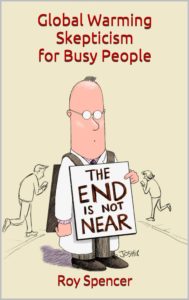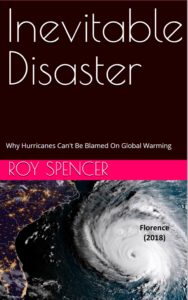 I sometimes get asked for a concise and accessible summary of my skeptical views on global warming. After a year or more of thinking and writing, my new Kindle book Global Warming Skepticism for Busy People is meant to fill that need.
I sometimes get asked for a concise and accessible summary of my skeptical views on global warming. After a year or more of thinking and writing, my new Kindle book Global Warming Skepticism for Busy People is meant to fill that need.
As a bonus, I guarantee it will be easier to understand than Neil deGrasse Tyson’s Astrophysics for People in a Hurry.
At nearly 32,000 words with 40 high-res illustrations it’s more comprehensive than my previous Kindle books, but still readable in about 2-3 hours. The book is not meant to cover all of the skeptical views out there, but rather everything that I believe is most important to the global warming and energy policy debate. (If people convince me I’ve missed a couple of subjects that need to be addressed, it is easy and fast to update Kindle books.)
Maybe the best way to summarize what is in the book is to list the chapter titles:
Preface
1. Overview of the Reasons for Skepticism
2. The Five Big Questions
3. Skepticism versus Alarmism
4. The Unholy Alliance: Politics and Science
5. How Could 97% of Scientists Be Wrong?
6. What is the Greenhouse Effect?
7. What Causes Temperature Change?
8. The Good News about Increasing CO2
9. The U.N. IPCC Consensus: Government-Funded Biased Science
10. Climate Models Exaggerate Recent Warming
11. Warming since the 1800s Suggests Climate Models are Too Sensitive
12. How the Reliance on IPCC Climate Models Affects You
13. Why is Warming Not Progressing as Predicted?
14. Refuting Common Climate Delusions
Conclusions
That last chapter is where I refute the frequent media claims about worsening heatwaves, wildfires, droughts, floods, hurricanes, tornadoes, weather-related disaster losses, sea level rise, sea ice melt, ice sheet collapse, and ocean acidification.
I consider this my most complete treatment of the subject in one place, with my latest position on a variety of subjects. I have references to some of the latest findings and events of interest — as recent as September 3, 2018. I’ve included hyperlinks where appropriate so that readers can easily investigate my claims for themselves.
I hope you find it entertaining and informative. And, again, I am open to suggestions for material I might have missed… keeping in mind I am not aiming for the most exhaustive treatment of global warming skepticism, but the most effective one.
*******************************************************************************
ALSO: I have updated and expanded my Kindle book Inevitable Disaster: Why Hurricanes Can’t be Blamed on Global Warming, with new information and inclusion of Hurricane Florence. This 2nd Edition should go live tonight.


 Home/Blog
Home/Blog



